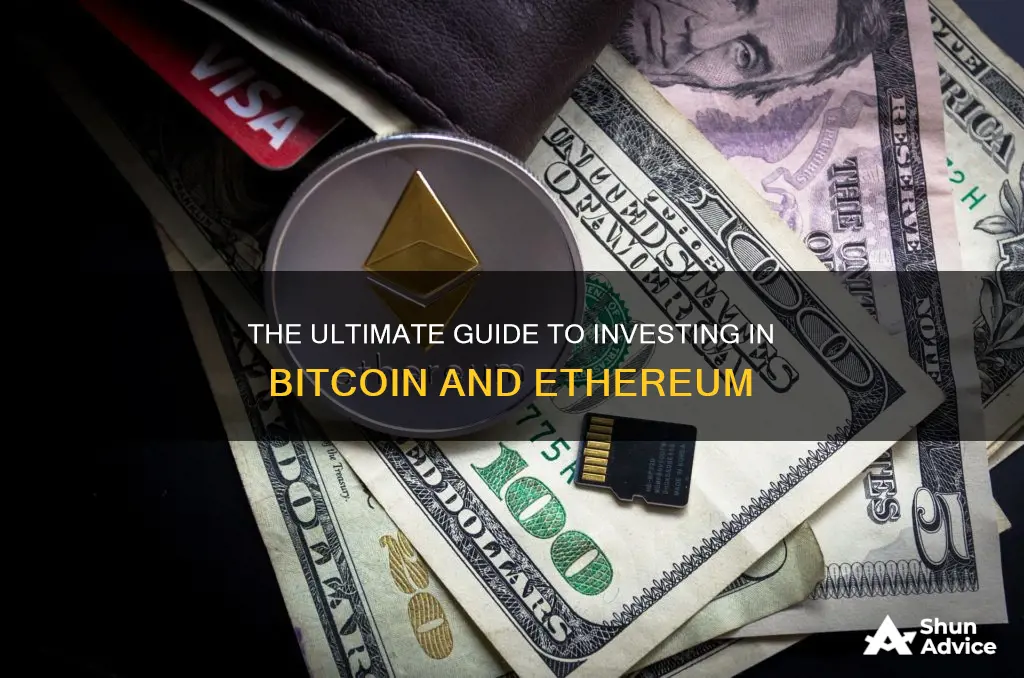
Bitcoin and Ethereum are the two leading cryptocurrencies, with a combined market cap of about 70% of the entire global cryptocurrency market. While Bitcoin was the first cryptocurrency, Ethereum has gained popularity due to its ability to support more complex software. This article will discuss how to invest in these two cryptocurrencies and the key differences between them.
| Characteristics | Values |
|---|---|
| Purpose | Bitcoin was designed as a way to carry out payments, while Ethereum can support more complex software. |
| Market Value | As of 2024, Bitcoin is the most highly valued cryptocurrency, with a market cap of $1.3 trillion. Ethereum's market cap is $420 billion. |
| Traditional Finance Acceptance | Bitcoin has seen greater acceptance by traditional finance, with the approval of spot Bitcoin ETFs in 2024. |
| Smart Contracts | Ethereum can support smart contracts, while Bitcoin cannot. |
| Transaction Verification | Bitcoin uses an energy-intensive method of verifying transactions known as Bitcoin mining. Ethereum has transitioned to a less energy-intensive process called staking. |
| Environmental Impact | Bitcoin's energy-intensive mining process has led to significant criticism. Ethereum's staking process has fewer environmental effects. |
| Transaction Fees | Ethereum fees have tended to be higher than those for Bitcoin. |
| Availability | Both Bitcoin and Ethereum are widely available on cryptocurrency exchanges. |
| Investment Value | Many people buy both Bitcoin and Ethereum for their perceived investment value rather than their current utility. |
What You'll Learn

Choosing a crypto-trading service or venue
Security and Regulation:
The security of your funds should be a top priority. Look for crypto exchanges that implement robust security measures such as two-factor authentication (2FA), cold storage wallets, and encryption protocols. Ensure that the exchange complies with relevant regulatory standards to protect yourself from potential scams or legal complications.
Reputation and Track Record:
Research the reputation and history of the exchange. Look for user reviews, community feedback, and the exchange's record of security breaches. Opt for exchanges with a solid reputation and a proven track record of reliable service.
Supported Crypto-assets:
Different exchanges offer different crypto-assets. Make sure the exchange you choose supports the crypto-assets you want to trade or invest in, such as Bitcoin (BTC) and Ethereum (ETH). Highly regulated crypto exchanges may have a smaller number of assets available due to stringent listing methodologies.
Liquidity:
Liquidity refers to how easy it is to buy or sell a crypto-asset without significantly impacting its price. Higher liquidity ensures smoother transactions and minimizes the risk of slippage. Choose an exchange with good liquidity to ensure your orders are executed promptly at fair prices.
User Interface and Experience:
An intuitive and user-friendly interface is important, especially for beginners. Look for exchanges with a clean and easy-to-navigate interface suitable for your level of experience. Additionally, check if the exchange offers a mobile app for trading on the go.
Fees:
Exchanges charge fees for deposits, withdrawals, and trading activities. Compare the fee structures of different exchanges to find one that aligns with your budget and trading preferences. Be cautious of hidden fees or excessively high charges, as they can eat into your profits.
Customer Support:
Prompt and reliable customer support is crucial, especially when you encounter issues or have queries. Check if the exchange provides multiple channels for customer support, such as live chat, email, or phone. Responsive customer support can save you time and provide assistance when needed.
Geographical Restrictions:
Some crypto exchanges have geographical restrictions and are only available in specific regions. Ensure that the exchange you choose operates in your country or region and complies with local regulations. Also, consider whether the exchange offers localized language support.
Trading Tools and Features:
Advanced traders often require access to a variety of trading tools and features, such as charting tools, order types, stop-loss options, and margin trading. If you have specific trading requirements, ensure that the exchange offers the necessary tools to facilitate your trading strategy.
Transparency and Reporting:
Transparency is essential in the crypto world. Look for exchanges that provide regular reports on trading volume and audits. Transparent exchanges inspire trust and enable you to make informed investment decisions.
When choosing a crypto-trading service or venue, consider your level of experience, investment goals, and the level of security and customer support you require. Compare different exchanges and their features to find the one that best suits your needs.
Smart Strategies to Invest 10K in Bitcoin
You may want to see also

Connecting your exchange to a payment option
Depending on the exchange, you may be required to provide personal identification information, such as a picture of your driver's license or Social Security card, as well as details about your employer and the source of your funds. The procedure is very similar to setting up a standard brokerage account.
At most exchanges, you can link your bank account directly or connect it to a debit or credit card. Although it is possible to use a credit card to purchase cryptocurrency, the volatility of cryptocurrency prices could cause the overall cost of purchasing a token to skyrocket when combined with a credit card's interest charges. It's worth noting that while Bitcoin is legal in the U.S., some banks may question or even block deposits to crypto-related sites or exchanges.
Fees vary for deposits made via bank account, debit card, or credit card, and exchanges also charge fees per transaction. It is important to research the fees associated with different payment methods before making a decision.
Gordon Ramsay's Bitcoin Adventure: Has He Invested?
You may want to see also

Placing an order
Once you have chosen a crypto-trading service or venue, the next step is to place an order.
Cryptocurrency exchanges have evolved to mimic stockbrokerage features. Crypto exchanges offer several order types and ways to invest. Almost all crypto exchanges offer both market and limit orders, and some also provide stop-loss orders.
Kraken offers the most order types, including market, limit, stop-loss, stop-limit, take-profit, and take-profit limit orders.
Exchanges also offer ways to set up recurring investments, allowing clients to dollar-cost average into their investments of choice. For example, Coinbase lets users set recurring purchases for every day, week, or month.
It is important to remember that Ether (ETH) is a currency and should be treated as such by investors. You do not buy shares of Ether like stocks or ETFs. Instead, you are exchanging your dollars for Ether tokens. There are no dividends or payouts. Your only hope is that in the future, other people on the Internet will pay you more for your tokens than you bought them for.
The Ultimate Investment: Bigger Than Bitcoin?
You may want to see also

Safe storage
There are multiple ways to store crypto, and each method has its pros and cons. The two main categories that wallets fall into are custodial/non-custodial and hot/cold.
Custodial vs Non-Custodial Wallets
Custodial wallets involve a third party, such as an exchange, that manages the private keys. Non-custodial wallets, on the other hand, give users full ownership of the keys.
Hot vs Cold Wallets
Hot wallets hold funds online and can be accessed easily, while cold wallets hold funds offline in cold storage.
- Hardware wallets are a type of cold wallet that allows users to hold their private keys securely offline. These wallets can be brought online to make transactions, and the signing of a transaction occurs on the physical hardware device itself, separate from the user's computer, making it even more secure. Examples include Ledger Nano X and Trezor.
- Mobile wallets are hot wallets held on smartphones, usually self-custodial. While they are great for sending or paying with crypto, they are less secure than cold wallets and are not recommended for storing large amounts.
- Paper wallets were the only cold storage option in the early days of crypto. They are created by printing out a private and public key. Once funds are sent to the public key, they are taken offline and can only be accessed by sweeping the private key into a hot wallet. However, paper wallets are prone to user error and are not commonly used anymore.
When choosing a storage method, consider factors such as the amount invested in crypto, how often you will want to spend/send your crypto, and your level of technical expertise.
For added security, it is recommended to use a combination of hot and cold wallets or multiple wallets for different purposes. For example, you could use a hardware wallet for long-term cold storage and a mobile wallet for spending and transacting.
Additionally, always create backups for your wallets and educate yourself on the mechanics of your chosen wallet to minimize the chance of user error.
Strategic Bitcoin Investment: Choosing the Right Coins
You may want to see also

Pros and cons of Bitcoin and Ethereum
Pros and Cons of Bitcoin
Bitcoin was the first cryptocurrency on the market and has the best brand recognition and most liquidity, making it the most widely accepted cryptocurrency. It is also underpinned by blockchain technology, which is designed to protect against fraud or identity theft. Its value is based on supply and demand, not political interference. Bitcoin has a faster transaction speed than fiat currency. The 21 million cap on bitcoins could drive prices higher by making the coin more scarce.
However, Bitcoin's price is highly volatile. It has limited functionality and uses an extreme amount of energy, which is bad for climate change. Bitcoin doesn't provide 100% anonymity, and it can be vulnerable to security risks.
Pros and Cons of Ethereum
Ethereum is a platform that supports the development of other projects, including decentralised applications and smart contracts. It leverages blockchain technology for its decentralised, transparent system. The developer community is one of the largest. The platform processes transactions faster than Bitcoin. Ethereum recently completed an upgrade that reduced its carbon footprint by 99.95%.
On the other hand, Ethereum is not Bitcoin, which is the most popular cryptocurrency in the world. The transaction fees are potentially higher than on the Bitcoin platform. It is slow compared to alternative platforms, and the unlimited supply could dampen demand for tokens.
A Beginner's Guide to Investing via Coinbase
You may want to see also
Frequently asked questions
Bitcoin was the first cryptocurrency and is a blockchain-based, decentralised digital currency. It is a payment method and an alternative to fiat currencies like the US dollar. Ethereum, on the other hand, is a blockchain platform that supports smart contracts and secure financial transactions. Its native cryptocurrency is Ether.
You need a cryptocurrency exchange account, personal identification documents, a secure internet connection, a payment method, and a personal digital wallet outside the exchange account. You can buy both Bitcoin and Ethereum on popular cryptocurrency exchanges such as Coinbase, Gemini, eToro, and Binance.
Both Bitcoin and Ethereum are prone to extreme price volatility. Buying either crypto requires a high-risk tolerance.







